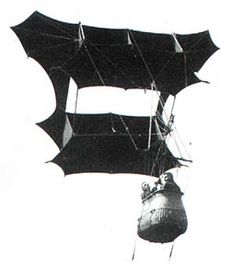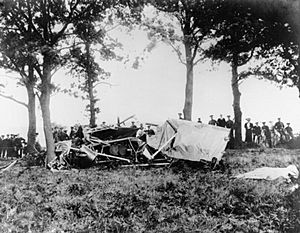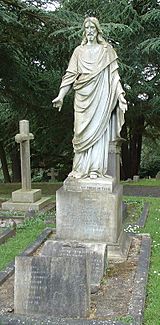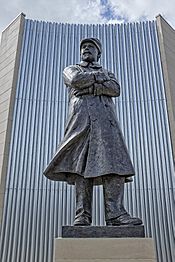Samuel Franklin Cody facts for kids
Quick facts for kids
Samuel Franklin Cody
|
|
|---|---|
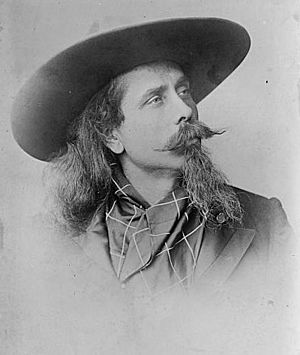
Samuel Franklin Cody in 1909
|
|
| Born | 6 March 1867 Davenport, Iowa, USA
|
| Died | 7 August 1913 (aged 46) Cove Common, Farnborough, United Kingdom
|
| Occupation | Showman, aviator, aircraft designer |
| Spouse(s) | Maud Maria Lee |
| Children | 4 |
Samuel Franklin Cowdery (later known as Samuel Franklin Cody; 6 March 1867 – 7 August 1913, born Davenport, Iowa, USA) was a Wild West showman and early pioneer of manned flight. He is most famous for his work on the large kites known as Cody War-Kites, that were used by the British before World War I as a smaller alternative to balloons for artillery spotting. He was also the first man to fly an aeroplane built in Britain, on 16 October 1908. A flamboyant showman, he was often confused with Buffalo Bill Cody, whose surname he took when young.
Kites
It is not clear why Cody became fascinated by kite flying. Cody liked to recount a tale that he first became inspired by a Chinese cook; who, apparently, taught him to fly kites, whilst travelling along the old cattle trail. However, it is more likely that Cody's interest in kites was kindled by his friendship with Auguste Gaudron, a balloonist Cody met while performing at Alexandra Palace. Cody showed an early interest in the creation of kites capable of flying to high altitudes and of carrying a man. Leon also became interested, and the two of them competed to make the largest kites capable of flying at ever-increasing heights. Vivian too became involved after a great deal of experimentation.
Financed by his shows, Cody significantly developed Lawrence Hargrave's double-cell box kite to increase its lifting power, especially by adding wings on either side. He also developed a sophisticated system of flying multiple kites up a single line, which was capable of ascending to many thousands of feet or of carrying several men in a gondola. He patented his design in 1901, and it became known as the Cody kite.
Balloons were then in use for meteorological and military observation, but could only be operated in light winds. Cody realised that kites, which can only be operated in stronger winds, would allow these activities to be carried out in a wider range of weather conditions. His kites were soon adopted for meteorology, and he was made a Fellow of the Royal Meteorological Society.
In December 1901, he offered his design to the War Office as an observation "War Kite" for use in the Second Boer War, and made several demonstration flights of up to 2,000 ft in various places around London. A large exhibition of the Cody kites took place at Alexandra Palace in 1903. Later, he succeeded in crossing the English Channel in a Berthon boat towed by one of his kites. His exploits came to the attention of the Admiralty, who hired him to look into the military possibilities of using kites for observation posts. He demonstrated them later in 1903, and again on 2 September 1908, when he flew them off the deck of battleship HMS Revenge. The Admiralty eventually purchased four of his War Kites.
In 1905, using a radically different design looking more like a tailless biplane, he devised and flew a manned "glider-kite". The machine was launched on a tether like a kite, and the tether was then released to allow gliding flight. The design showed little similarity to his earlier kites, but had more the appearance of a tailless biplane. It was notable in being the first aircraft to use ailerons (in fact they were elevons) effectively to control roll.
Cody eventually managed to interest the British Army in his kites. In 1906, he was appointed Chief Instructor of Kiting for the Balloon School in Aldershot and soon after joined the new Army Balloon Factory down the road at Farnborough, along with his purported son Vivian. The Factory would eventually become the Royal Aircraft Establishment, and Vivian Cody would go on to a long and successful career as a technical specialist. In 1908, the War Office officially adopted Cody's kites for the Balloon Companies he had been training. This group would in due course evolve into the Air Battalion of the Royal Engineers, No. 1 Company of which later became No. 1 Squadron, Royal Flying Corps and eventually No. 1 Squadron Royal Air Force.
Finally, in 1907, he created an unmanned "power-kite". Somewhat similar to his standard kite but with bigger wings and a tailplane with twin fins in place of the rear cell, this was fitted with a 15 hp Buchet engine. It was not allowed to fly free; Cody strung a long aerial wire down the length of the Farnborough Balloon Shed and flew it indoors.
All that remained to him was to bring together the manned free-flying glider and the power-kite's engine to create Britain's first aeroplane.
Death
Cody continued to work on aircraft using his own funds. On 7 August 1913, he was test flying his latest design, the Cody Floatplane, when it broke up at 200 feet (61 m) and he and his passenger, the cricketer William Evans, were killed at Ball Hill, Laffans Plain, Cove Common near Farnborough. The two men, not strapped in, were thrown out of the aircraft and the Royal Aero Club accident investigation concluded that the accident was due to "inherent structural weakness", and suggested that the two might have survived the crash if they had been strapped in. Cody's body was buried with full military honours in the Aldershot Military Cemetery; the funeral procession drew an estimated crowd of 100,000.
Adjacent to Cody's own grave marker is a memorial to his only son, Samuel Franklin Leslie Cody, born Basel, Switzerland 1895, who joined the Royal Flying Corps and was killed in Belgium on 23 January 1917 while serving with 41 Squadron.
Legacy
A team of volunteer enthusiasts built a full-sized replica of British Army Aeroplane No 1 to commemorate the 100th anniversary of the first flight. It is on permanent display at the Farnborough Air Sciences Trust Museum in Farnborough. The display is about three hundred metres from the take-off point of the historic flight.
Memorials to Cody include:
- When Cody was testing his first aeroplane, he tied it to a tree in order to assess the pulling power of its propeller. The tree became known as the Cody Tree and survived for many years. Later an aluminium replica was cast by apprentices of the Royal Aircraft Establishment, and this now marks the spot.
- A commemorative statue of Cody, adjacent to the Farnborough Air Sciences Trust Museum, was unveiled by 94-year-old Captain Eric "Winkle" Brown in August 2013.
- Cody Technology Park, Farnborough was named in his honour.
- Cody Cricket Club, based at Farnborough, was named after him.
- Cody lived for the last few years of his life in Ash Vale, Surrey, where his former house is marked by a blue plaque, and is adjacent to a car dealership called Cody's which features an aeroplane on its sign.
The Aldershot Military Museum has artifacts relating to Cody.
In April 2013, two of Vivian Cody's (real name Vivian King) grandsons appeared on BBC One's Antiques Roadshow with two Michelin Trophies, won by Cody, which were each valued at £25,000 – £30,000.
The Broomfield hoax
G. A. Broomfield had been an assistant and friend to Cody after he left the Army and moved to Laffan's Plain. In 1948, he presented to the Science Museum, Kensington, a model of the No.1 machine which was wrong in many details. He claimed that the first flight had been in May 1908. This was one month before a similar claimed first flight by A. V. Roe, and Broomfield wanted to establish primacy for Cody. Roe's claim was later disallowed, but by then Broomfield was too deep in his story to back out.
The next year, Broomfield made the same claim to the Royal Aircraft Establishment, and caused a new plaque with the date of 16 May 1908 to be made for the Cody Tree. The story first appeared in print in 1951, and again in 1952, in articles published by independent researchers. A fuller account of the fictitious day's flying appeared in Broomfield's biography of Cody, Pioneer of the Air, 1953. It was endorsed by Geoffrey de Havilland who provided the Foreword and C. G. Grey, editor of the journal Aeroplane, who wrote the Introduction. The hoax was not exposed until 1958, the 50th anniversary of flight in Britain, when three investigators, G. W. B. Lacey from the Science Museum, A. T. E. Bray from the R.A.E. and the independent historian Charles Gibbs-Smith, asked Broomfield for clarifications.
List of aircraft
- Cody War Kites (1901)
- Cody glider-kite (1905)
- Cody power-kite (1907)
- British Army Aeroplane No 1 (1908) or Cody No. 1 or Cody Cathedral
- Cody Michelin Cup Biplane (1910)
- Cody Circuit of Britain Biplane (1911)
- Cody monoplane (1912)
- Cody V (1912) (Cody Military Trials Biplane)
- Cody Floatplane (1913)
- Kuntz, Jerry A Pair of Shootists: The Wild West Story of S. F. Cody and Maud Lee. Norman. OK: University of Oklahoma Press, 2010.
- Lewis, P British Aircraft 1809–1914 London: Putnam, 1962.
- Pawle, Gerald The Secret War 1939–45. London, Harrap, 1956.
- Taylor, M.J.H. and Mondey, David Milestones of Flight. London: Jane's, 1983.
- Walker, P.; "Early Aviation at Farnborough" (Two volumes), Macdonald (Volume I 1971, Volume II 1974).
Images for kids


